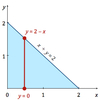SOA Probability Flashcards
If A ⊂ B then (A n B)
(A n B) = A
Probability Generating Function Defined as PGF where
Px(t) =
Px(t) = E [tX]
E ( X ( X -1 ) ) = 2nd Moment of what Generating Function?
PGF - Probability Generating Function
E [X ∣ j ≤ X ≤ k] - continuous case
Integrate numerator from j to k
( ∫ x ⋅ fX (x) dx )
÷
( Pr ( j ≤ X ≤ k ) )
Percentile for Discrete Random Variables
Fx(πp) ≥ p
i.e the function at πp has to atleast be equal or greater than the percentile p
E [X | j ≤ X ≤ k] - Discrete Case
Sum numerator from x = j to k
( ∑ (x)( Pr [j ≤ X ≤ k] )
÷
( Pr [j ≤ X ≤ k] )
Percentile for Continous Random Variable
density function fX(πp) = p
Has to equal the percentile
Finding mode of discrete random variable
calculate probabilities of each possible value and choose the one that gives the largest probability
Finding mode of continuous random variable
take derivative of density function set it equal to 0 and solve for mode. (finding local maximum of function)
Cumulative Distribution Function (CDF) of a probability density function (PDF)
integrate from lowest value of X to the variable x itself
0 <f></f>
∫ f(t) dt
Chebyshev’s Inequality
Pr( |X-µ| ≥ kσ ) ≤ ( 1 / k2 )
How to break up the inequality of Chebyshev’s Equation
Pr( |X-µ| ≥ kσ )
=
Pr( (X-µ) ≥ kσ ) + Pr( (X-µ) ≤ -kσ )
Univariate Transformation CDF METHOD
From X to Y
1.) Given PDF of X find CDF of X
2.) Perform Transformation where FY( y ) = P( Y ≤ y ) with subsitution
3.) Restate CDF of Y using CDF of X ,
then subsitute CDF of X found in step 1 into CFD of Y
4.) Take Derivative of CDF of Y to find PDF of Y
Univariate Transformation PDF METHOD
From X to Y
1.) Get PDF of X if not given
2.) Find PDF of Y using the formula
fY( y ) = fX( [g-1( y )] ) • | (d/dy) g-1( y ) |
3.) Integrate PDF of Y to get CDF of Y if required
Discrete Uniform PMF
( 1 / b - a + 1)
Discrete Uniform E[X]
( a + b / 2 )
Discrete Uniform Var[X]
[( b - a + 1 )2 - 1]
÷
12
Bernoulli’s E[X]
p
Bernoulli’s Var[X]
pq
Bernoulli’s MGF
pet + q
Bernoull’s Variance Short-cut for Y = (a-b)X + b
(b - a)2• pq
Property of Expected One RV: E[c]=
E[c]=c, c = constant
Property of Expected One RV: E[c⋅g(X)]=
E[c⋅g(X)]= c ⋅ E[g(X)]
Property of Expected One RV: E[g1(X)+g2(X)+…+gk(X)] =
E[g1(X)+g2(X)+…+gk(X)]
=
E[g1(X)] + E[g2(X)]+ …+E[gk(X)]



